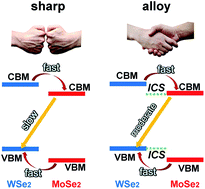Suppressing photoexcited electron–hole recombination in MoSe2/WSe2 lateral heterostructures via interface-coupled state engineering: a time-domain ab initio study†
Abstract
Photoexcited carrier dynamics at the interface play a vital role in two-dimensional heterostructure-based photovoltaic and photoelectric devices. This study systematically investigates how the interface morphologies (i.e., alloy and sharp interfaces) control the photogenerated carrier transfer and electron–hole recombination processes in MoSe2/WSe2 lateral heterostructures. It is revealed that both interfaces exhibit a remarkable photogenerated carrier separation rate within a few picoseconds. More surprisingly, the sharp interface exhibits an exceptional long carrier lifetime up to 1 nanosecond, which is longer than that of the alloy interface by a factor of 1.5. This is ultimately attributed to the vanishing interface-coupled states that effectively limit the transition channel and suppress the electron–hole recombination. This study provides insights into the photogenerated carrier dynamics in heterostructure interfaces and sheds light on the rational design of high-performance transition metal dichalcogenide heterostructure-based photovoltaic and photoelectric devices.



 Please wait while we load your content...
Please wait while we load your content...